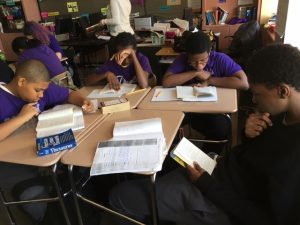
19 May Cultivating Young Readers in Communities of Poverty
Posted at 14:43h
in The Lopez Effect

By the time my scholars enter Mott Hall Bridges Academy, many are pre-teens who are reading two or three years below grade level. As an educator it can be a daunting task getting children who struggle with phonics and comprehension to become excited about reading, but with a little hope and key strategies you can create a culture of literacy that can cultivate a community of young readers:
- Classroom libraries! Give kids options by incorporating picture books, comic books, chapter books, magazines, anthologies of various genres that will peak a child’s interest and give them the power of choice.
- Use technology! This is perfect opportunity to use apps that allow books to be download on handheld devices or computers because we are all connected out technology. A wonderful program called MyOn has been designed to customized book choices for kids based on a quick survey that determines a kids reading level and interest. This was extremely helpful in engaging scholars with special needs and those who are considered at-risk and reluctant readers.
- Blog for thought! There are so many great blogs that cover a wide variety of topics that are quick reads and easily accessible. Whether its about empowerment, inspiration, fashion, food, love, or sports, you can find a post online with a simple google search. This not only engages readers, but can also encourage opportunities of them into writers as well.
- Create a space! Create an inviting and warm environment that inspires and encourages a child to read. Create a reading corner that may have a bin full of books, a carpet to establish a reading zone/area, bean bags or a sofa for comfortable seating. Don’t forget the reading lamp, it can create a library environment
- Let’s Read!Assign reading groups within the classroom. This can be homogenous so the teacher can provide targeted support to a specific need or heterogenous to encourage cooperative learning among peers within a classroom. Another idea is to establish a book club that could meet during lunch, after school, or on the weekends, where kids volunteer to participate and select their own books that will be read.
- Time it! At minimum, have kids read 15-30 minutes of sustained reading time during the beginning of the class to build the habits of good readers and establish a culture of reading.
- Listen Up! Audiobooks are great way of engaging kids who struggle with reading and help to build fluency. Many textbooks offer audio text and various publishers offer audio versions of their books as well.
- Top Reader! Kids love to be rewarded for their great efforts, so turn their struggle into a victory. Each reader should keep a log of reading that their parents should sign and teachers should collect. At the end of each month the reader with the most books read can receive a prize such as certificate of achievement, ‘reader of the month’ photo, or a book they can keep of their own just as an example.
- Author Connection! There are several ways to connect with an author and invite them to speak to your class. Many have Facebook, Twitter or LinkedIn accounts, as well as their own website that they use to promote their work. Don’t be afraid to reach out ask if a school visit would be possible; in the event location may present a barrier, Google Hangouts and Skype can turn a classroom into a video conference room.
- Love it! When you are enthusiastic about reading and share your love for learning, it can become infectious. Good readers did one thing–they never stopped reading.

